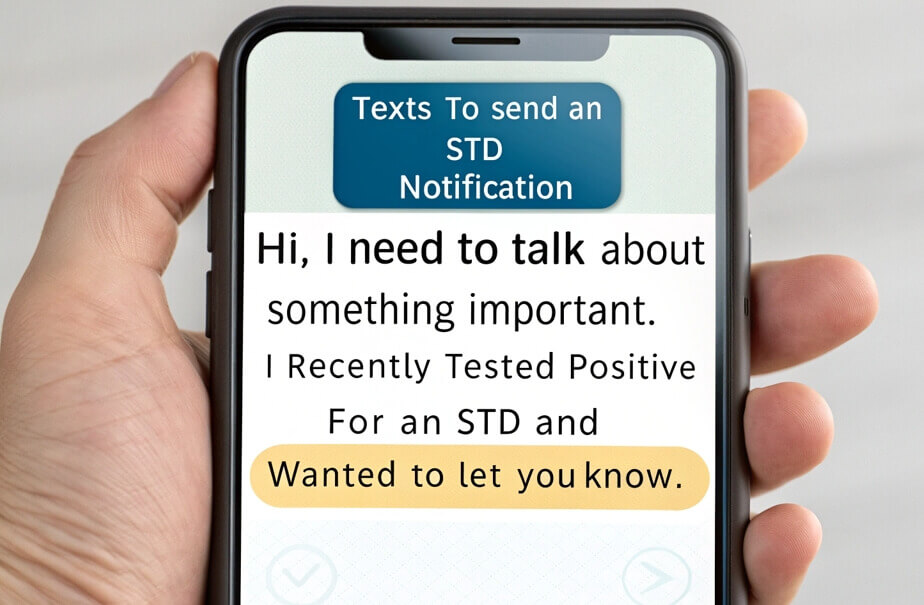Trust in relationships is one of the most important things and sexual health is not an exception. It is important to note that when you get an STI, reporting it to your partner is not only right but compulsory.
There are several methods of delivering such personal information, ranging from a face-to-face conversation with a partner to receiving an SMS with an STD indication. Such anonymous messaging services are most useful in situations when talking directly becomes awkward.
But what if you’re too anxious to face them directly? This is where an anonymous STD text message can help. Now let us discuss how to use this subtle way to send anonymous texts about an STD and give the information to your partner.
Understanding STIs & STDs
There is a great need to raise the educational level of the public on STIs and STDs to prevent the marginalization of persons affected. From an analysis of the definitions, prevalence, and health effects of STIs and STDs, the public shall be in a better position to protect themselves and their partners.
Definitions
The terms STI and STD are related but have key differences. An STI, or sexually transmitted infection, refers to an infection that can be transmitted through sexual contact. Many individuals with an STI may not exhibit any symptoms, which can lead to a lack of awareness about their condition.
On the other hand, an STD, or sexually transmitted disease, is diagnosed when an STI progresses to the point where symptoms or health complications are present. For example, the human papillomavirus (HPV) is a sexually transmitted infection that may not cause any symptoms in some individuals. However, certain strains of HPV can lead to genital warts or cervical cancer, which are classified as STDs.
Common Types and Prevalence
STIs are very common all over the world with millions of people being infected every year. According to the CDC of the United States, it is estimated that nearly 20 million new cases of STIs are reported annually in the United States. Examples include chlamydia, gonorrhea, syphilis, and herpes, and these are easily spread through sexual contact.
Of these, chlamydia is the most common, and each year, more than 1.5 million cases are reported. Several STIs like HPV and Herpes go undetected by the patients as they do not manifest symptoms that call for testing.
Health Implications
Untreated STIs can lead to severe complications, including infertility, pelvic inflammatory disease, chronic pain, and increased susceptibility to HIV. Pregnant individuals with untreated STIs risk transmitting infections to their babies, potentially causing severe health issues. Timely diagnosis and treatment are critical to preventing long-term consequences and protecting overall well-being.
By staying informed, individuals can reduce the risk of STIs and promote healthier relationships.
4 Ways to Tell Someone About an STD
Disclosing an STD to someone can be uncomfortable, but it’s an essential step for their health and safety. Choosing the right communication method depends on your relationship and comfort level. Here are four effective ways to approach the conversation:

In-Person Communication
Face-to-face discussions are ideal for honesty and trust. Speak calmly, provide factual information about the STD, and answer questions with empathy. This method allows for immediate clarification and reassurance, helping to maintain openness and understanding.
Phone Calls
A phone call offers real-time interaction without the pressure of a face-to-face meeting. You can explain the situation clearly and provide emotional support while maintaining some personal distance, making it a balanced option for disclosure.
Text Messages
If direct communication feels overwhelming, sending a text message is a practical choice. Craft a clear and empathetic message. Use an anonymous STD text service to ensure privacy while delivering the information responsibly.
Anonymous Messaging Services
Anonymous messaging services like TellYourPartner enable you to send anonymous STD notifications discreetly. These services are beneficial for individuals who prioritize privacy while ensuring their partner receives critical health information without revealing their identity.
How to Craft an Anonymous Message?
Communicating about STDs anonymously requires clarity, accuracy, and sensitivity. An anonymous message can effectively inform your partner while protecting your privacy. Here’s how to create a thoughtful and informative anonymous STD text message:
Details on Sending Messages
When you have to send anonymous STD texts, ensure you state the STI in question and if he has any signs. Also, give information about where they can get tested close by or any other relevant information for them to get treated early. Using factual language and yet all-encompassing to the feelings of the recipient of the message is always effective.
Templates for Notifications
Here are five sample templates for sending an anonymous text about STD:
- You may have been exposed to [STI name]. Please get tested at your earliest convenience. Testing locations: [link or details]. Your health is important.
- This is an anonymous message to inform you of potential exposure to [STI name]. It’s vital to get tested and seek treatment if necessary.
- You should know that you may be at risk for [STI name]. Testing and treatment can protect your health. Visit [link] for testing resources.
- Someone you were recently intimate with has tested positive for [STI name]. Please get tested at [testing location] or use an at-home kit.
- As a precaution, please test for [STI name] due to possible exposure. This is an anonymous notification to ensure your health and safety.
Copy and personalize these templates to suit your situation. You can send personalized anonymous notifications through Anonsms; if you want a more convenient and quick way to send anonymous STI notifications, you can try TellYourPartner, which allows you to easily, discreetly and safely alert your partner with just a few clicks.
Top Tips for Telling Someone Who May Be at Risk of STDs
Informing someone that he or she may be in danger of an STD is not easy, but it is an important step toward his or her improvement. This way it is believed that the response will be clearer and more supportive since you know what is coming. Here are some essential tips to guide you:

Preparation Techniques
Start the conversation with your mind and tone set – remain calm and confident. This keeps misunderstandings to a bare minimum and prepares you with answers to some of the questions they may be likely to ask you. These preparations assist you in keeping your cool and making a certain conversation to be helpful and compassionate.
Providing Factual Information
Provide information on the STI, explaining its signs or complications and what treatment is available. Telling them the facts may comfort them that you are interested in helping them get healthier and will allow them to make proper decisions about their health.
Clarifying Terminology
To eliminate confusion between the two terms, distinguish between STIs and STDs and then briefly define each of them. Being clear helps erase misconceptions and every partner must have a clear understanding of the situation.
Ensuring Certainty About Diagnosis
Before starting the conversation make sure that the diagnosed illness is real. It makes your communication responsible and deliberate as you are sure of the details you are offering to your audience.
Frequently Asked Questions(FAQs)
How do you text someone you have chlamydia?
Use a clear and empathetic message: “I recently tested positive for chlamydia. Please get tested to ensure your health and well-being.”
Do you legally have to tell someone you have an STD?
Legal requirements vary by location. In many jurisdictions, disclosure before sexual activity is mandatory to avoid legal repercussions.
Can you sue someone in Canada for giving you an STD?
Yes, you can pursue legal action if they knowingly infected you without informing you beforehand, as this is considered negligent or intentional harm.
Do STDs show up on medical records?
Yes, if you test positive, your results are recorded in your confidential medical history, accessible only by authorized healthcare providers.
What STDs are not curable?
Some examples are HIV, herpes, and hepatitis B, but these diseases can well be controlled by modern medications and constant monitoring.
What can you do if someone gives you an STI?
Seek medical treatment promptly, inform other potential partners, and consult a lawyer if you suspect negligence or intentional harm.
You May Want to Know
After receiving an STD notification, it could be difficult to talk with your partner, but it doesn’t have to be; you can do it with some help. From advocating groups to anonymous testing possibilities, help is available to help you. Here’s what you need to know:
Support Services
There are sexual health clinics, STD check-up centers, women’s helplines, and health clinics like Planned Parenthood. They provide one-on-one counseling to assist you on how to discuss matters concerning STIs and take you through a list of contacts for counseling and medical help.
Testing Resources
The anonymous testing can be done at clinics or through the use of home test kits which increases one’s privacy. Most testing providers also explain to you what to do next depending on your test results. Search it online or go to the nearby clinic to get help.
Legal Considerations
Legal requirements for STI disclosure vary by region. Failure to disclose can have legal repercussions in some regions. For example, the United Arab Emirates has strict laws regarding the disclosure of HIV status, which can lead to legal repercussions for non-disclosure.
Final Thoughts
Disclosure of STIs is essential to encourage trust and ensure health is not jeopardized. Whether through an anonymous STD text message or a direct meeting, this step proves that a person is responsible and thoughtful. Anonymous messaging services like TellYourPartner make it possible to report an STD risk to your partner while keeping things private. Don’t wait until you have to face a situation that necessitates seeking a health check!

 Anonsms
Anonsms
 TellYourPartner
TellYourPartner




